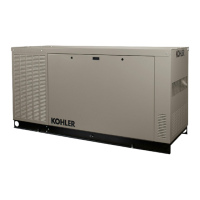TP-6811 7/1656 Section 4 Cooling System
4.8 Filling Cooling System
Model
Coolant Capacity, L (gal.)
Generator Set With Block Heater
38RCL 15 (4.0) 15.6 (4.2)
48RCL 17 (4.5) 17.6 (4.7)
48RCLA 20.8 (5.5) 21.4 (5.7)
60RCL 20.8 (5.5) 21.4 (5.7)
Figure 4-4 Coolant Capacity
Note: Do not add coolant to a hot engine. Adding
coolant to a hot engine can cause the cylinder
block or cylinder head to crack. Wait until engine
has cooled.
1. Close the radiator’s coolant drain valve and tighten
the hose clamps.
2. Fill the radiator with the recommended coolant
mixture of 50% ethylene glycol and 50% clean,
softened water to inhibit rust/corrosion and prevent
freezing. The coolant capacity is shown in
Figure 4-4.
3. Operate the engine with the radiator cap removed
until the thermostat opens and the upper radiator
hose becomes hot.
4. Stop the engine and allow it to cool.
5. Add coolant to the radiator to just below the
overflow tube on the filler neck. See Section 1,
Service Views, for the overflow tube location.
6. Replace the radiator’s pressure cap.
7. Maintain the coolant level in the coolant overflow
bottle between the High and Low markings. See
Section 1, Service Views, for the coolant overflow
bottle location.
8. Re-energize the block heater, if equipped.
4.9 Pressure Cap
The pressure cap raises the boiling point of the coolant,
enabling higher operating temperatures. If the cap
leaks, replace it with the same rating type of cap. The
pressure cap typically has the pressure rating stamped
on the cap body. Find the pressure cap rating in
Figure 4-5.
Item Rating
Pressure cap 97 kPa (14 psi)
Figure 4-5 Pressure Cap Rating

